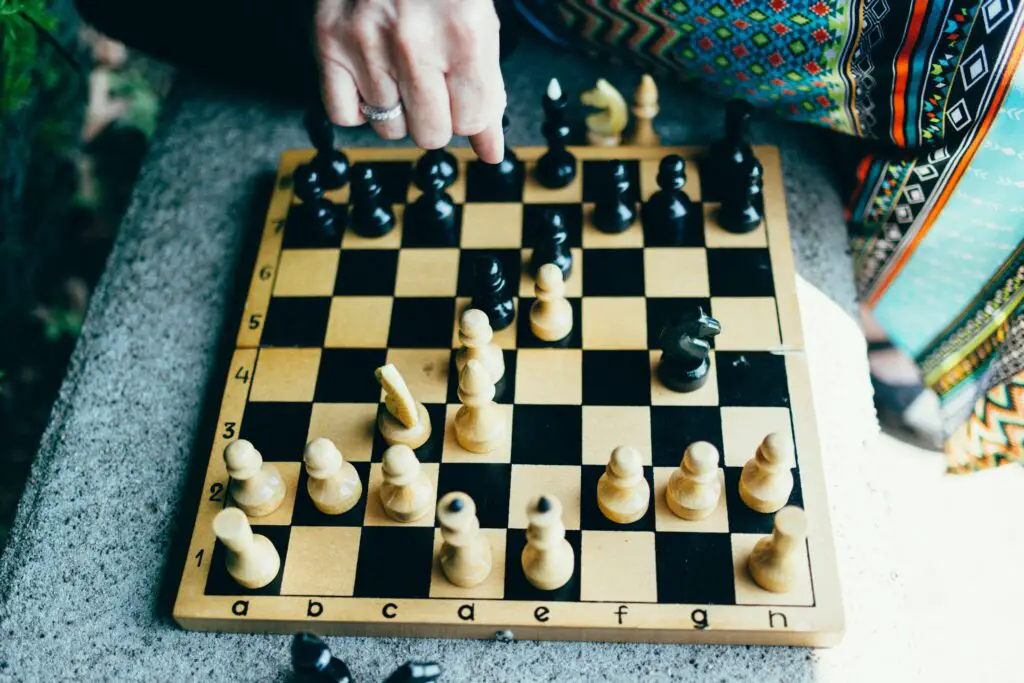Is it possible to win a chess game without losing any pieces?
Contents
- 1 Is it possible to win a chess game without losing any pieces?
- 2 Understanding Chess Pieces and Their Strategic Significance
- 3 The Essence of Preserving Pieces: A Strategic Imperative
- 4 Tactics and Techniques for Piece Conservation
- 4.1 1. Piece Exchanges:
- 4.2 2. Avoiding Unnecessary Risks:
- 4.3 3. Prophylactic Thinking:
- 4.4 4. Centralization and Coordination:
- 4.5 5. Retreating and Repositioning:
- 4.6 6. Pawn Structure Awareness:
- 4.7 7. Piece Safety in Endgames:
- 4.8 8. Piece Imbalance Assessment:
- 4.9 9. Patience and Long-Term Planning:
- 4.10 10. Continuous Evaluation and Adaptation:
- 5 Challenges and Considerations: Navigating the Chessboard Minefield
- 6 Conclusion: Unraveling the Enigma of Chess Mastery
Chess, the timeless game of strategy and intellect, has captured the fascination of minds across centuries. As players immerse themselves in the intricacies of the board, a burning question often arises: Is it possible to emerge victorious in a game of chess without sacrificing a single piece? Join me on this journey as we delve into the depths of chess mastery to uncover the truth behind this intriguing query.
Understanding Chess Pieces and Their Strategic Significance
Before we embark on our exploration, it’s essential to grasp the fundamental roles of chess pieces. Each pawn, knight, bishop, rook, queen, and king possesses unique movements and powers. Pawns, the foot soldiers of the game, advance cautiously, while knights leap with finesse. Rooks dominate open files, bishops glide diagonally, and queens reign supreme with versatility. The king, though regal, requires protection above all else.
In the symphony of chess, every piece harmonizes to orchestrate strategic maneuvers. Yet, the age-old adage echoes: “In chess, as in life, sacrifice is sometimes necessary.” Indeed, sacrificing pieces for positional advantage or checkmate is a hallmark of masterful play.
Let’s consider a classic example from the world of chess: the immortal game between Adolf Anderssen and Lionel Kieseritzky, played in London in 1851. In this historic encounter, Anderssen delivered a stunning sacrificial onslaught, culminating in a breathtaking checkmate known as “The Evergreen Game.” His audacious sacrifices captivated the chess world, demonstrating the power of bold, sacrificial play.
The Essence of Preserving Pieces: A Strategic Imperative
As we ponder the feasibility of winning without losing pieces, we confront the essence of preservation. Piece conservation isn’t merely a tactical choice; it’s a strategic imperative. Each loss diminishes our arsenal, weakening our position on the board. Thus, the art of chess entails not only capturing opponents’ pieces but safeguarding our own with utmost care.
Throughout history, legendary chess encounters have showcased the prowess of players who meticulously preserved their pieces. From the immortal games of yore to modern grandmaster clashes, strategic finesse often hinges on prudent piece management.
Consider the strategic brilliance of Anatoly Karpov, the 12th World Chess Champion, renowned for his positional mastery and prophylactic play. In numerous games, Karpov demonstrated the art of piece conservation, patiently maneuvering his forces while denying his opponents’ counterplay. His strategic depth and precise calculation exemplify the value of preserving pieces in the pursuit of victory.
Tactics and Techniques for Piece Conservation
In the crucible of chess, victory demands astute tactics and unwavering resolve. Opening gambits set the stage, with players jockeying for control while safeguarding their forces. Mid-game skirmishes intensify, as pieces dance across the board in a delicate balance of power. Endgame maneuvers culminate in decisive strokes, where the fate of kings hangs by a thread.
Tactical maneuvers such as pins, forks, and skewers offer avenues for gaining advantage without sacrificing pieces. Strategic maneuvering allows players to exploit weaknesses while fortifying their defenses. Through astute calculation and foresight, players navigate the labyrinth of possibilities, striving to emerge unscathed.
1. Piece Exchanges:
- Evaluate the consequences of every potential piece exchange. Only trade pieces when it benefits your position strategically, such as eliminating a key defender or weakening your opponent’s pawn structure.
2. Avoiding Unnecessary Risks:
- Refrain from overly aggressive or speculative moves that expose your pieces to unnecessary risks. Prioritize solid and positionally sound moves that maintain piece safety and stability.
3. Prophylactic Thinking:
- Anticipate your opponent’s threats and preemptively neutralize potential dangers through prophylactic moves. Proactively safeguard your pieces from potential attacks or forks by improving their positions or reinforcing vulnerable squares.
4. Centralization and Coordination:
- Centralize your pieces to maximize their activity and influence over the board. Coordinate your pieces harmoniously to support each other’s strengths and compensate for weaknesses, creating a cohesive and dynamic formation.
5. Retreating and Repositioning:
- Recognize when to retreat your pieces to safer squares or reposition them to more advantageous locations. Don’t hesitate to relocate pieces that are under pressure or out of play, seeking better opportunities for activity and control.
6. Pawn Structure Awareness:
- Be mindful of the impact of pawn structures on piece mobility and coordination. Avoid pawn moves that restrict the movement of your own pieces or create weaknesses that can be exploited by your opponent.
7. Piece Safety in Endgames:
- Protect your pieces in the endgame, where their individual importance increases as the number of pieces on the board diminishes. Avoid exposing your pieces to unnecessary risks and prioritize their safety to maintain your material advantage.
8. Piece Imbalance Assessment:
- Evaluate the balance of pieces on the board and assess the relative strengths and weaknesses of each side. Strive to maintain a favorable piece balance while exploiting any disparities to your advantage.
9. Patience and Long-Term Planning:
- Exercise patience and restraint in your gameplay, avoiding impulsive moves that compromise piece safety or positional integrity. Plan strategically for the long term, preserving your pieces for sustained pressure and gradual improvement.
10. Continuous Evaluation and Adaptation:
- Continuously reassess the dynamics of the position and adapt your piece management strategies accordingly. Remain vigilant for tactical opportunities and positional nuances that may require adjustments to your approach.
Let’s examine a strategic masterpiece from modern chess: the encounter between Magnus Carlsen and Viswanathan Anand during the 2014 World Chess Championship. In this pivotal game, Carlsen showcased his tactical acumen and positional understanding, gradually outmaneuvering Anand to secure victory without sacrificing a single piece. His precise calculation and patient maneuvering underscore the significance of piece conservation in elite-level play.
While the prospect of winning without losing pieces tantalizes the imagination, it’s not without its challenges. The dynamic nature of chess renders every move a calculated risk. Sacrifices may be unavoidable, especially in the pursuit of victory. Moreover, the psychological aspect looms large, as players grapple with uncertainty and pressure.
Adaptability is key, as strategies evolve in response to unfolding dynamics. Flexibility allows players to pivot gracefully, seizing opportunities while mitigating risks. Indeed, the journey to victory is fraught with perils, yet therein lies the thrill of the chase.
Consider the pivotal moments in the 1972 World Chess Championship between Bobby Fischer and Boris Spassky. In their epic struggle for supremacy, both players faced immense pressure, with the eyes of the world upon them. Fischer’s relentless pursuit of victory drove him to the brink of exhaustion, yet his unwavering determination and strategic insight ultimately prevailed. His ability to navigate the chessboard minefield with precision and poise remains a testament to the indomitable spirit of the human mind.

Conclusion: Unraveling the Enigma of Chess Mastery
In conclusion, the question “Is it possible to win a chess game without losing any pieces?” remains a tantalizing enigma. While achieving such a feat may seem elusive, the pursuit of excellence fuels our endeavors. Through strategic acumen, foresight, and sheer determination, players navigate the labyrinthine depths of the chessboard, seeking triumph amidst adversity.
So, dear reader, as you embark on your own chess odyssey, remember: the journey is as enriching as the destination. Embrace the challenges, savor the victories, and never cease to explore the boundless horizons of chess mastery. After all, in the game of chess, as in life, the possibilities are endless.







